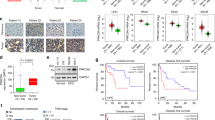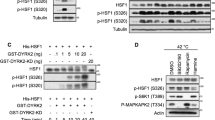Abstract
XBP1 is a well-characterized regulator of the unfolding protein response that is activated in response to unfolded or misfolded proteins or nutrient deprivation. The conventional wisdom is that XBP1 is activated to coordinate the unfolded protein response and promote cellular survival under stresses. A recent study provides intriguing evidence that, in triple-negative breast cancer, XBP1 plays a major role in promoting oncogenesis and cancer stem cell properties. Unexpectedly, XBP1 accomplishes this by recruiting hypoxia-inducible factor 1α and activating oncogenic transcriptional programs. This study reveals a surprising hierarchy and alliance between two stress regulators with distinct transcriptional outputs to promote an aggressive oncogenic state.
Similar content being viewed by others
Background
Cells within a solid tumor are constantly exposed to fluctuating physical and chemical conditions in the microenvironment, including pH dysregulation, oxidative stress, and nutrient deprivation [1]. To cope with these fluctuations, tumor cells demonstrate a wide spectrum of mechanisms that sense and respond to these stresses. For example, a low partial pressure of oxygen (pO2) level stabilizes the hypoxia-inducible factors (HIFs) and triggers a hypoxia response [2]. Similarly, various oxidative stresses promote the nuclear translocation of NRF2 to induce a set of genes that enhances oxidative-stress tolerance. Although these responses facilitate stress adaptations, many of these proteins and pathways also play an active role in promoting or repressing oncogenesis. For example, the HIFs [3] and NRF2 [4] can be oncogenic and their constitutive activation directly contributes to tumor development. Hypoxia pathway is more active in triple-negative breast cancers (TNBCs) than in other breast cancers [5]. However, the physiologic cause for enhanced HIF-1α protein levels leading to the elevated hypoxia response remains unknown since these tumors, as a group, do not have lower pO2[5].
The IRE1-XBP1 pathway is one of the three branches of the unfolding protein response (UPR) that senses and responds to the accumulation of misfolded proteins in the endoplasmic reticulum (ER) caused by nutrient deprivation and other stresses. The transmembrane ER protein IRE1 senses these stresses and excises a 26-bp segment from the XBP1 mRNA, converting the inactive unspliced XBP1 to the active spliced XBP1 (XBP1s) whose translated protein triggers the transcription of many UPR genes [6]. Since the IRE1-XBP1 pathway is considered an adaptive survival mechanism under stress, the inhibition of the UPR reduces cellular survival and tumor growth [7]. Therefore, therapeutic targeting of IRE1-XBP1 may hamper the UPR required for cancer cell survival under stress.
The article
In a recent letter to Nature, Chen and colleagues [8] provided intriguing data to show that XBP1 acts as a tumor driver that is required for oncogenesis and cancer stem cell phenotypes associated with TNBC. Unexpectedly, XBP1 mediates its oncogenic properties by physically interacting with and recruiting HIF-1α to initiate the hypoxia response. The recruitment is essential to induce oncogenic and self-renewal phenotypes in TNBC. An XBP1 gene expression signature identified by using ChiP-seq analysis significantly overlaps with the HIF-1α signature and is associated with poor prognosis in TNBC. Most importantly, epistasis analysis indicates that XBP1 lies upstream of HIF-1α, occupying the regulatory regions and recruiting HIF-1α, via direct physical interaction, to the promoter regions of their shared target genes. Therefore, XBP1 is required for a robust hypoxia expression program in TNBC. The authors conclude from these results that that XBP1s activation and promoter occupancy is not just a passive adaptive response for survival under stress, but rather is a driving oncogenic event in TNBC.
The viewpoint
This article provides a potential explanation for the elevated hypoxia pathway activation in TNBC and breast cancer stem cells. Moreover, although both HIF-1α and XBP1 are stress-responsive proteins, high baseline activities of both transcriptional factors can be found in TNBC without apparent stress exposure. What triggers the IRE1-XBP1 pathway in TNBC and breast cancer stem cells? One obvious candidate is hypoxia since it activates both XBP1 and HIF-1α. However, the pO2 concentration needed to activate the UPR is much lower (pO2 < 0.01%) than what is needed to activate HIF-1α [9]. Furthermore, whereas hypoxia can be readily triggered by low pO2, XBP1 is activated only by combined low pO2 and lactic acidosis [10]. Therefore, XBP1 may be activated by combined metabolic stresses associated with the acquisition of cancer stem cell and TNBC properties. The higher UPR in TNBC is shown by a dilated ER [8] and increased sensitivity to hsp90 inhibitors that kill cells by hindering the UPR [11]. Such a high level of UPR in TNBC may be caused by increased protein production, higher oxidative stress, or lower levels of nutrients driven by vigorous glycolysis and altered glutamine metabolism [12]. Currently, TNBC is treated primarily by cytotoxic chemotherapies. Targeting the IRE1-XBP1 pathway, such as with an inhibitor of IRE1 (for example, STF-083010) [13], may have significant therapeutic value for TNBC.
Of course, these results also raise questions for further investigation. For example, why does the co-occupancy of XBP1 and HIF-1α occur in TNBC but not luminal breast cancer cells? Such differences may be explained by TNBC-specific chromatin accessibility status or other available co-activator proteins. Specifically in TNBC, XBP1 may serve as a `pioneer factor' [14] that recruits other co-activators to trigger and maintain HIF-1α stability. A recent study has identified at least seven different subtypes of TNBCs with varying sensitivity to hsp90 inhibitors [15]. Therefore, it will be important to determine the extent of this XBP1-HIF-1α co-regulation among the subsets of TNBCs as well as cancer stem cells from other tumor types.
In conclusion, this study shows an unexpected dominant role for XBP1 in the recruitment and activation of HIF-1α-driven oncogenesis in TNBCs. Like many other stress response pathways, these proteins are not just passive players to keep tumors alive under stress. Instead, stress response proteins can be oncogenic drivers that coordinate stress tolerance with other transcriptional factors to enhance and modulate their expression programs. Therefore, proteins such as HIF-1α and IRE1-XBP1 may be excellent targets in our efforts to treat cancers that have yet to benefit from other targeted therapeutics.
Abbreviations
- ER:
-
Endoplasmic reticulum
- HIF:
-
Hypoxia-inducible factor
- pO2:
-
partial pressure of oxygen
- TNBC:
-
Triple-negative breast cancer
- UPR:
-
Unfolding protein response
- XBP1s:
-
spliced XBP1
References
Gatenby RA, Gillies RJ: A microenvironmental model of carcinogenesis. Nat Rev Cancer. 2008, 8: 56-61. 10.1038/nrc2255.
Majmundar AJ, Wong WJ, Simon MC: Hypoxia-inducible factors and the response to hypoxic stress. Mol Cell. 2010, 40: 294-309. 10.1016/j.molcel.2010.09.022.
Semenza GL: HIF-1 and human disease: one highly involved factor. Genes Dev. 2000, 14: 1983-1991.
Sporn MB, Liby KT: NRF2 and cancer: the good, the bad and the importance of context. Nat Rev Cancer. 2012, 12: 564-571. 10.1038/nrc3278.
Gatza ML, Kung HN, Blackwell KL, Dewhirst MW, Marks JR, Chi JT: Analysis of tumor environmental response and oncogenic pathway activation identifies distinct basal and luminal features in HER2-related breast tumor subtypes. Breast Cancer Res. 2011, 13: R62-10.1186/bcr2899.
Hetz C, Martinon F, Rodriguez D, Glimcher LH: The unfolded protein response: integrating stress signals through the stress sensor IRE1alpha. Physiol Rev. 2011, 91: 1219-1243. 10.1152/physrev.00001.2011.
Romero-Ramirez L, Cao H, Nelson D, Hammond E, Lee AH, Yoshida H, Mori K, Glimcher LH, Denko NC, Giaccia AJ, Le QT, Koong AC: XBP1 is essential for survival under hypoxic conditions and is required for tumor growth. Cancer Res. 2004, 64: 59435947-10.1158/0008-5472.CAN-04-1606.
Chen X, Iliopoulos D, Zhang Q, Tang Q, Greenblatt MB, Hatziapostolou M, Lim E, Tam WL, Ni M, Chen Y, Mai J, Shen H, Hu DZ, Adoro S, Hu B, Song M, Tan C, Landis MD, Ferrari M, Shin SJ, Brown M, Chang JC, Liu XS, Glimcher LH: XBP1 promotes triple-negative breast cancer by controlling the HIF1alpha pathway. Nature. 2014, 508: 103-107. 10.1038/nature13119.
Rzymski T, Milani M, Pike L, Buffa F, Mellor HR, Winchester L, Pires I, Hammond E, Ragoussis I, Harris AL: Regulation of autophagy by ATF4 in response to severe hypoxia. Oncogene. 2010, 29: 4424-4435. 10.1038/onc.2010.191.
Tang X, Lucas JE, Chen JL, LaMonte G, Wu J, Wang MC, Koumenis C, Chi JT: Functional interaction between responses to lactic acidosis and hypoxia regulates genomic transcriptional outputs. Cancer Res. 2012, 72: 491-502. 10.1158/0008-5472.CAN-11-2076.
Caldas-Lopes E, Cerchietti L, Ahn JH, Clement CC, Robles AI, Rodina A, Moulick K, Taldone T, Gozman A, Guo Y, Wu N, de Stanchina E, White J, Gross SS, Ma Y, Varticovski L, Melnick A, Chiosis G: Hsp90 inhibitor PU-H71, a multimodal inhibitor of malignancy, induces complete responses in triple-negative breast cancer models. Proc Natl Acad Sci U S A. 2009, 106: 8368-8373. 10.1073/pnas.0903392106.
Terunuma A, Putluri N, Mishra P, Mathé EA, Dorsey TH, Yi M, Wallace TA, Issaq HJ, Zhou M, Killian JK, Stevenson HS, Karoly ED, Chan K, Samanta S, Prieto D, Hsu TY, Kurley SJ, Putluri V, Sonavane R, Edelman DC, Wulff J, Starks AM, Yang Y, Kittles RA, Yfantis HG, Lee DH, Ioffe OB, Schiff R, Stephens RM, Meltzer PS, et al: MYC-driven accumulation of 2-hydroxyglutarate is associated with breast cancer prognosis. J Clin Invest. 2014, 124: 398-412. 10.1172/JCI71180.
Papandreou I, Denko NC, Olson M, Van Melckebeke H, Lust S, Tam A, Solow-Cordero DE, Bouley DM, Offner F, Niwa M, Koong AC: Identification of an Ire1alpha endonuclease specific inhibitor with cytotoxic activity against human multiple myeloma. Blood. 2011, 117: 1311-1314. 10.1182/blood-2010-08-303099.
Zaret KS, Carroll JS: Pioneer transcription factors: establishing competence for gene expression. Genes Dev. 2011, 25: 2227-2241. 10.1101/gad.176826.111.
Lehmann BD, Bauer JA, Chen X, Sanders ME, Chakravarthy AB, Shyr Y, Pietenpol JA: Identification of human triple-negative breast cancer subtypes and preclinical models for selection of targeted therapies. J Clin Invest. 2011, 121: 2750-2767. 10.1172/JCI45014.
Acknowledgments
We appreciate the support of the National Institutes of Health (CA125618 and CA106520) and the US Department of Defense (W81XWH-12-1-0148) and comments from Jeffrey Marks.
Author information
Authors and Affiliations
Corresponding author
Additional information
Competing interests
The authors declare that they have no competing interests.
Rights and permissions
This article is published under an open access license. Please check the 'Copyright Information' section either on this page or in the PDF for details of this license and what re-use is permitted. If your intended use exceeds what is permitted by the license or if you are unable to locate the licence and re-use information, please contact the Rights and Permissions team.
About this article
Cite this article
Keenan, M.M., Ding, CK.C. & Chi, JT. An unexpected alliance between stress responses to drive oncogenesis. Breast Cancer Res 16, 471 (2014). https://doi.org/10.1186/s13058-014-0471-1
Published:
DOI: https://doi.org/10.1186/s13058-014-0471-1




